George A. Romero’s Night of the Living Dead (1968): restored at last
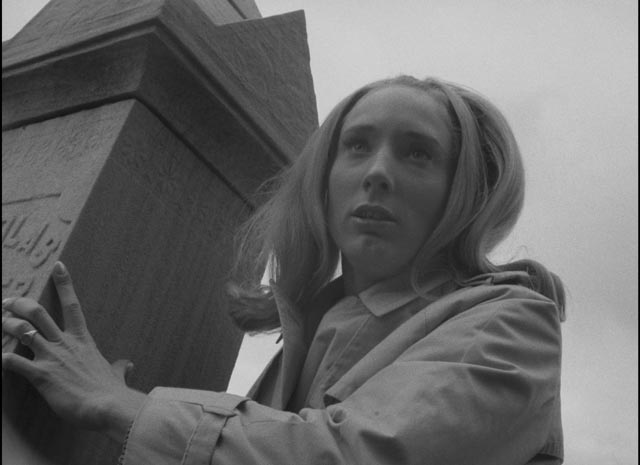
George A. Romero’s Night of the Living Dead (1968) was made on a shoestring budget far from the movie mainstream. It was not too surprising that the people at Pittsburgh’s commercial and industrial film company The Latent Image should have settled on a horror film for their first feature; horror has often been the genre of choice for regional filmmakers with limited resources, because it’s virtually guaranteed to return what investors have put into it. Also not surprising was the initial response to the film by those critics who bothered to look at it: it was generally dismissed as crude, incompetent, tasteless. But there was something different about this particular movie, something perhaps sensed by Roger Ebert in his notorious screed, first published in Chicago on January 5, 1969, and later picked up by the Reader’s Digest to prompt some kind of national outrage about the direction American movies were heading in the late 1960s.
Ebert’s response initially blinded him to the film’s qualities because he saw it at a kids’ Saturday matinee, surrounded by boys and girls who were progressively traumatized as the horrors piled up on their way to an ending which, even for the ’60s, was distressingly hopeless. Rather than fully engaging with a key pop culture moment – the emergence of an adult seriousness in a genre too often dismissed as beneath serious consideration – Ebert instead railed against those who had lured unsuspecting kids in with the promise of cozy scares and then kicked them in the guts. Ebert’s response indicated that distributors and exhibitors (and parents) were simply unprepared for the shift which was occurring; Night of the Living Dead announced that horror at the end of a turbulent decade dominated by pointless wars and assassinations and seismic social disruption was no longer just a silly diversion. It could be used as a vehicle for social and political commentary on very real situations.
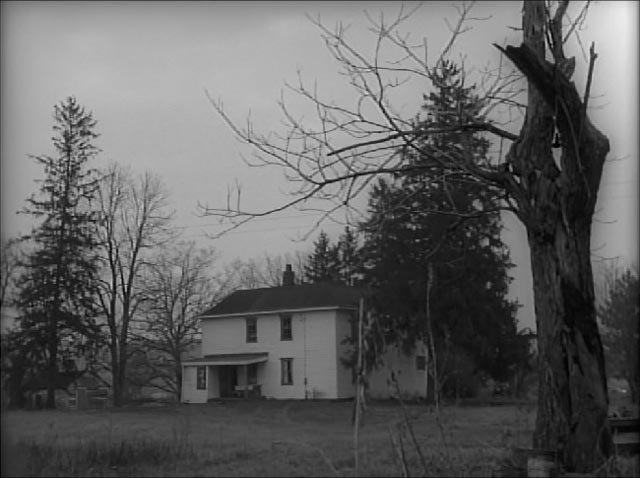
Emerging when it did, Night of the Living Dead has undeniable echoes of the Vietnam War and the parallel violence at home; its images elicit obvious associations with what people were seeing every day on their televisions. The box had brought the horrors of very real violence and death into the sanctity of the family’s private space. Security was an illusion. And so we find ourselves in the film trapped in a remote house besieged by incomprehensible monsters among an unstable, thrown-together “family” which reflects the social rifts of the larger society. The people inside the house turn on one another and ultimately prove as much a danger to themselves as the mindless flesh-eating creatures trying to break in. This in fact became the main central theme which runs through all of Romero’s Dead movies; it becomes ever more difficult to discern who the real monsters are – after all, the ravenous dead are merely driven by some instinct beyond their control, while the besieged humans are supposed to be capable of reason and moral thinking, yet always fall short and succumb to self-destruction.
All of this came to be recognized over time – beginning with the film’s re-release in 1970 and its increasing influence over other filmmakers, reinforced by the release of Romero’s epic follow-up Dawn of the Dead ten years later. But of course retrospect can distort perception. How much of what we now see in Night of the Living Dead was consciously placed there, how much was fortuitous accident? While the film reflected the time of its making, perhaps the most radical aspect of the production was the casting of Duane Jones as protagonist Ben, and yet placing a black actor at the centre of the film was not a deliberately transgressive decision; rather it reflected Romero’s judgment that Jones was the best actor available – a rare instance of genuinely “colour-blind” casting. But that practical decision gave the film far greater resonance than its horror elements by themselves could have done.
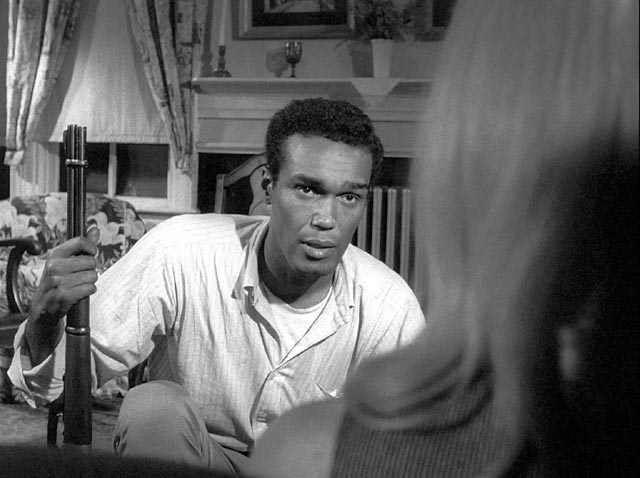
While Jones definitely stands out for the intensity and nuance of his performance, most of the cast is quite strong – the weakest element is the conventional ingenue couple Tom (Keith Wayne) and Judy (Judith Ridley); Wayne has an earnest awkwardness, but Ridley does have several expressive moments. Co-producer Karl Hardman, as cowardly Harry Cooper, gives depth to the potentially one-note character as scripted; interestingly, he’s driven by an insecurity which makes him a bully, but because the script makes nothing of Ben’s race, Harry never becomes an overt racist. If that element is part of his make-up, it’s hidden behind the more immediate conflict over male dominance. Marilyn Eastman as Harry’s wife Helen, through looks and silences, creates a strong portrait of a marriage which has settled into barely suppressed hostility and contempt. At that transitional moment, she’s a woman caught in a traditional role which she knows is no longer valid, but from which she hasn’t yet found an escape route.
The character of Barbra has sometimes been criticized for its perceived anti-feminist treatment of what initially appears to be the female lead. (Romero attempted to correct his “error” in his script for Tom Savini’s 1990 remake, making Barbara [Patricia Tallman] a fighter in the mold of Francine [Gaylen Ross] in Dawn of the Dead and Sarah [Lori Cardille] in Day of the Dead.) And yet Judith O’Dea nonetheless gives a strong and convincing performance as a woman suffering from shock, no longer able to function. The criticism of her “weakness” stands outside her role as a dramatic character; given what Barbra is going through, her response is plausible, and demands that she should be stronger and take a more active part are really demands to impose something on the narrative for external reasons. Within the ensemble, Barbra represents one of many responses to the crisis which are played out by the characters as a group – responses which reveal the inherent weaknesses which ultimately doom them all.
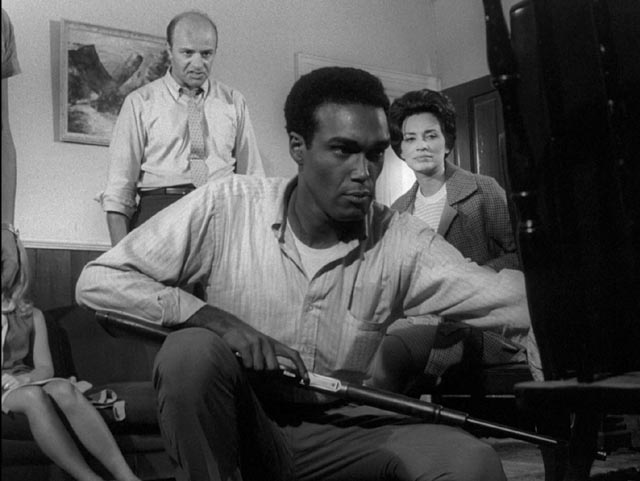
One of the great strengths of Romero and co-writer John A. Russo’s script is that it provides room for these weaknesses to be explored, giving the narrative the kind of depth which sets Night of the Living Dead apart from so many cheap exploitation movies. The central conflict within the group, which coalesces around Ben and Harry, is whether to hunker down in the basement and hope for rescue or to remain on the main floor with an option to retreat or escape if the opportunity arises. Ben is as firm in his belief in the latter option as Harry is in the former; in fact their dislike of each other simply reinforces their respective positions.
Ben’s self-assurance and Jones’ appealing performance, in contrast with Harry’s sweaty arrogance, bullying and moments of cowardice, put the audience firmly on Ben’s side – something which his race reinforces because it’s so satisfying to see the traditional underdog in a dominant position. And yet as events unfold, it becomes apparent that Harry was probably right; the basement was the best place to make a stand; Ben’s more active stance eventually precipitates the deaths of all the other characters and he himself finally survives the night by sealing himself in the basement.
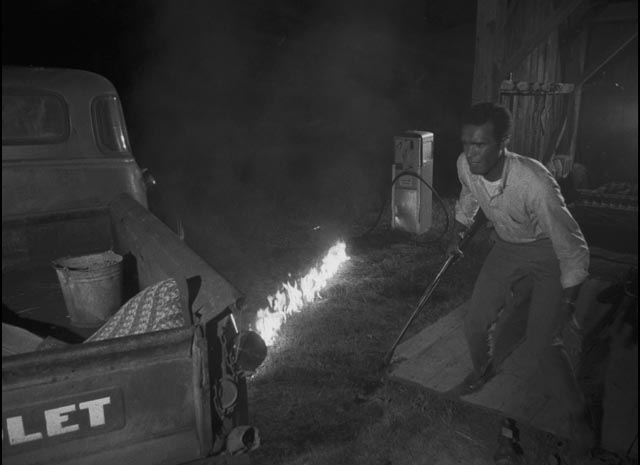
In the world of Night of the Living Dead, everyone is compromised; people are unable to form a cohesive alliance for mutual survival, the family itself collapses from the pressure of the violence – in what remains one of the film’s two most chilling sequences, Harry and Helen’s own daughter Karen (Kyra Schon) kills and eats her parents. The other devastating sequence, of course, is the unremittingly bleak ending in which the forces of societal violence, in the form of a sheriff’s posse scouring the countryside and gunning down the shambling ghouls, are no longer able to discern the difference between the living and the dead: having survived the horrific night, Ben doesn’t survive the rescue party. That image of a black man casually gunned down by the police resonates more today perhaps than it did at the time, but in 1968 it inevitably echoed images of armed police attacking Civil Rights and anti-war protesters. If the living dead evoked the increasing violence impinging on everyday life, there was no comfort to be found in the “forces of order” mobilized by the state.
*
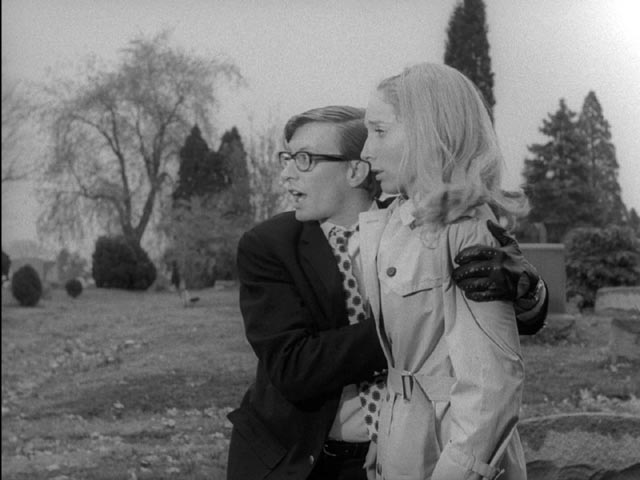
I first saw Night of the Living Dead in the summer of 1974, having already read a lot about it; even going in with high expectations, the film had a powerful impact. The familiarity instilled by many viewings over the years in various formats (VHS, laserdisk, DVD) has done nothing to diminish the film’s raw power. This is a tribute to George Romero’s considerable abilities. Even at that first viewing, I could recognize something which lifted the film above the usual run of low-budget horrors. Romero was a gifted cinematographer and editor and even with the limited means available (the film was shot piecemeal over a period of nine months) he invested a great deal of care in the look and tone. The stark black-and-white photography is rich in expressive angles, light and shadow and unsettling movement, while the editing is relentlessly propulsive. Romero, directing and shooting with the eye of an editor, builds each moment from carefully chosen visual fragments which never permit the viewer to relax and feel superior to the material.
This is not to say that the film is without flaws. The piecemeal production results in continuity issues – particularly some inconsistency regarding day and night. Romero was obviously still feeling his way with the ghouls and the make-ups are uneven. The first one we see (S. William Hinzman) attacking Barbra and Johnny (co-producer Russell Streiner) in the graveyard moves much more quickly and decisively than the ones which eventually surround the house. And I have always had to make a conscious effort not to be bothered by the fact that, when Ben furiously boards up the doors and windows, he ignores the two windows in the living room, while talking about how secure he’s made the house. It was years after first seeing the film that I heard Romero’s explanation – that there was a long drop outside those windows and it was obvious to the cast and crew that the ghouls couldn’t reach them. But there’s no way for the viewer to know this and Ben’s oversight seems inexplicable.
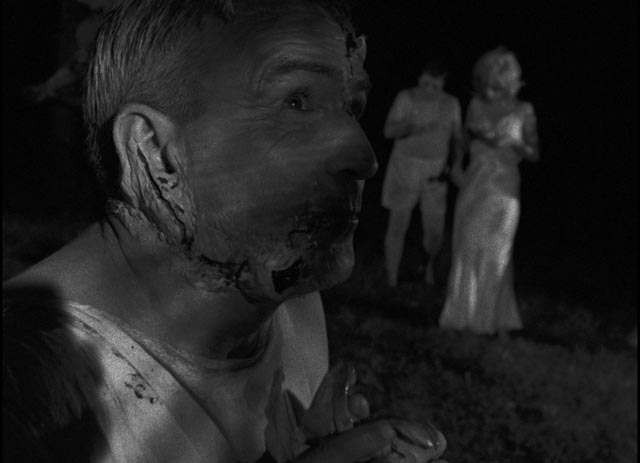
But these minor defects are ultimately unimportant in the greater context of the bleak nightmare created by Romero and his collaborators. Night of the Living Dead, beyond terrifying those kids on a Saturday afternoon in Chicago, went on to grow in stature over the years and wielded an influence on the horror genre and independent film production far beyond its makers’ modest ambitions. It was this small but remarkable film, along with the polished studio production of Roman Polanski’s Rosemary’s Baby the same year, which gave us the modern horror film, raising a generally disdained genre to one of the most enduring and profitable – and one which encompasses a wide range of intentions, from mere exploitation to serious commentary on our social, psychological and existential state.
*
The disk
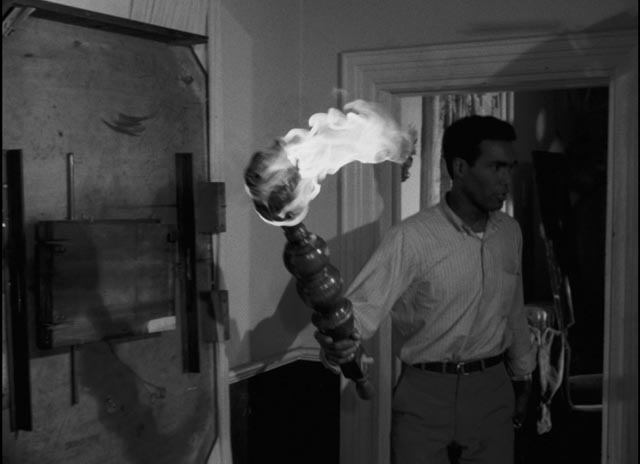
Like many filmmakers working on the fringes of the business, Romero and his collaborators ended up seeing very little money from their efforts. Night of the Living Dead was eventually picked up by a small distributor and through various circumstances (including inadvertently omitting an on-screen copyright notice, a technicality which bizarrely negated the filmmakers’ ownership of the movie), it ended up in a kind of public domain limbo. This was one reason that Romero decided to produce the remake in 1990; at least with that he could reassert some kind of ownership … but despite some interesting variations, it was a pale imitation of the original.
This situation also meant that the various home video releases were often technically compromised; although companies wanted to cash in on the film’s notoriety, they weren’t particularly willing to invest in any kind of preservation. This was somewhat rectified with Elite’s laserdisk edition in the ’90s and their subsequent DVD release in 2002, then Dimension’s remastered DVD in 2008. But without the protection of clear ownership, the film was also tampered with many times over the years; there were numerous colourized versions, and even a 3D conversion in 2009. One of the most egregious indignities inflicted on Night of the Living Dead was surprisingly perpetrated by none other than John Russo, whose “30th Anniversary Edition” in 1999 included newly shot additional scenes replacing original content, all intended to make it slicker and more fast-paced. It was a disaster.
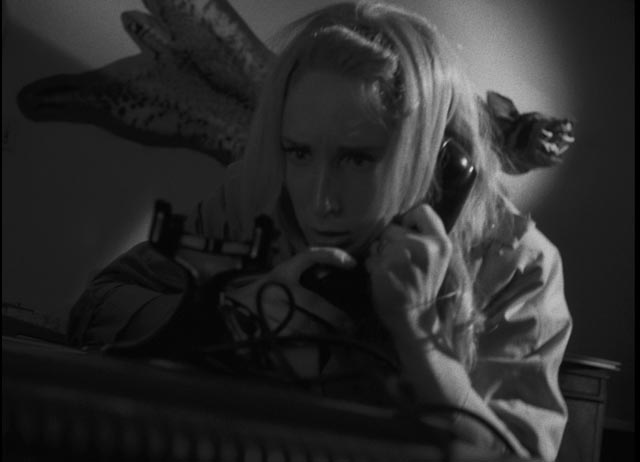
But the new Blu-ray from Criterion renders all previous releases redundant. With a 4K restoration funded by the Museum of Modern Art and The Film Foundation, supervised by Romero before his death last year, along with Russo, co-producer Russell Streiner and sound engineer Gary R. Streiner, the film has never looked better – in fact, it probably looks better than it ever did projected in a theatre. Except for a few brief moments taken from a 1968 fine-grain master, the restoration was made from the original 35mm negative. The image is sharp, with deep, rich contrast and a suggestion of grain which provides a pleasing film-like texture. Romero and Gary Streiner supervised restoration of the mono sound from multiple sources, including the original quarter-inch mix masters.
*
The supplements
Criterion has lavished attention on this small, low-budget film, showing it the respect it is due as one of the key American movies of the 1960s. The edition consists of two Blu-ray disks, the second devoted to almost three-and-half-hours of new and archival material.
Archival:
A reel of dailies (18:04), with an introduction by Gary Streiner (3:41), covers a surprisingly diverse number of scenes.
A brief, silent newsreel clip, taken from VHS, shows behind-the-scenes on the shoot (2:48).
Walking Like the Dead (13:04) collects interviews with several zombie extras, originally recorded in 2009.
A July 3, 1979, appearance by Romero, with Don Coscarelli, on the NBC Tomorrow show has the two filmmakers (promoting their recent releases, Dawn of the Dead and Phantasm) providing insightful answers to frequently banal questions from host Tom Snyder (18:20).
Higher Learning is an interview with Romero from the Toronto International Film Festival in 2012 (45:30).
Duane Jones is heard in an audio interview from December 13, 1987, just seven months before the actor’s death (21:56).
A 1994 interview with actress Judith Ridley is from the Elite laserdisk (10:42).
A brief news clip from 1967 about NASA’s Mariner probe, which had just passed close to Venus, suggests a possible source for the “explanation” provided by the talking heads on TV in the film (00:32).
There are also a couple of trailers, two TV spots and five radio ads for the film.
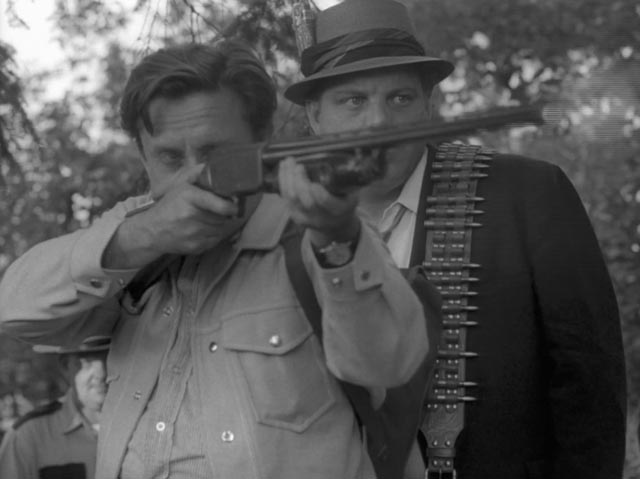
New material:
Light in the Darkness (23:41) intercuts interviews with Frank Darabont, Robert Rodriguez and Guillermo del Toro in which the filmmakers speak about the historical importance of Night of the Living Dead and its impact on their own work.
In Learning from Scratch (11:58), John Russo talks about his own connection with The Latent Image and his involvement with the production of Night of the Living Dead.
Tones of Terror (11:15) explores Romero’s use of library music to create the film’s effective score.
Limitations into Virtues (11:57) is a video essay by Tony Zhou and Taylor Ramos which analyzes Romero’s visual style, particularly the mix of a fixed camera for dialogue scenes (necessitated by the weight of the soundproof blimp) and the freer, more expressionist handheld material used for more active scenes where sound recording was not crucial; Zhou and Ramos argue convincingly that the tension created by these conflicting visual styles gives the film much of its destabilizing power.
*
Finally, the first disk includes two audio commentaries with Romero and the cast and crew originally recorded for the Elite laserdisk and – the oddest feature of the set – a transfer of the 16mm workprint (1:25:09) with an introduction by Russell Streiner (7:17). (There’s a large chunk missing from the second reel.) I wasn’t quite sure what to get out of this; having expected a variant cut, I found that it is virtually the same as the finished film, with a few slight differences and an alternate title (Night of Anubis), which the original distributor insisted on changing. Having worked with actual film in the early years of my own editing career, I wasn’t surprised by how dirty and battered the workprint is, but apart from offering a glimpse for modern viewers of a now-disappeared filmmaking process, this ragged version adds little to an understanding of the feature itself. I would have appreciated more information about it from Criterion. In fact, it made me wish that Criterion would study the text supplements which often accompany BFI and Arrow releases, which provide far more context for disk contents than Criterion’s standard critical essay (in this case by critic Stuart Klawans) focused solely on the feature itself. Given the volume of information about the feature provided in the disk supplements, the absence of any additional information on the workprint seems like an unfortunate oversight.
But what really matters in the end is the excellent quality of the presentation of Night of the Living Dead itself, and in this respect Criterion have given us what will undoubtedly be one of the finest releases of the year.
Comments
I would say that pieces like Ebert’s commentary on the audience are partially what propelled the film to success. It certainly made me want to see it! Just like Rex Reed on The Texas Chainsaw Massacre: “is positively ruthless in its attempt to drive you right out of your mind” and “The most horrifying motion picture I have ever seen.” I don’t even know if Reed gave it a good review, but his comments have been used to promote that movie for years.
Definitely, when it comes to horror, bad press is often good press!
I just ordered one. That and Nichols.
That’s pretty eclectic … you’ll be skewing Amazon’s customer recommendation algorithm!